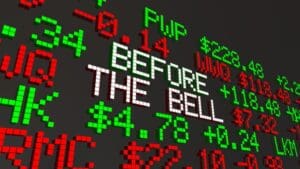Today’s economic data reflects a continued bifurcation in economic fortunes on both sides of the Atlantic. On the west side, S&P Global’s Flash PMIs depict strong momentum on optimism that the incoming administration will pass pro-business policies and serve to make further progress in onshoring manufacturing. But those same initiatives are viewed negatively on the other side, as European export-oriented economies are expected to struggle under the weight of hawkish US trade programs. The discrepancy is evident among rates and currency markets, with investors pricing in a sprint down the ECB’s monetary policy stairs, while the Fed is expected to descend its steps in slower fashion, with some pauses between meetings. Equities are gaining on both sides of the big pond, however, but the greenback continues to extend its run against its European peer.
Economic Activity Booms Post Election
The November Flash Purchasing Managers’ Indices (PMI) from S&P Global hit 57.0 and 48.8 in services and manufacturing, higher than the 55.2 and 48.8 expected and the 55 and 48.5 reported last month. Despite the modest improvement in the manufacturing gauge, output fell at a rate not experienced since December 2022. Conversely, S&P notes that anticipation of President-elect Donald Trump’s proposed tariffs and trade protection has helped improve sentiment in the goods producing sector, which is contributing to an increase in factory employment. At the same time, factories are trying to front-run tariffs by increasing their orders for imported input items. In the services sector, meanwhile, activity jumped at the fastest rate since March 2022. Meanwhile, cost pressures rose modestly across the overall economy, according to survey respondents.

Past performance is not indicative of future results
US Services Accelerate Fiercely
Optimism about President-elect Donald Trump’s business-friendly proposals, stronger economic growth and potentially lower interest rates have supported ferocious demand and confidence in the services sectors. However, services employment has declined for the fourth-consecutive month. Stock gains, fiscal stimulus and a tight labor market have contributed to staggering consumption figures ahead of the holiday season.
Eurozone Doldrums Continue
The eurozone economic doldrums have worsened and moved towards recessionary conditions with November’s HCOB Flash PMIs for manufacturing and services declining and falling below expectations. While the pace of manufacturing contraction eased modestly in October as depicted by the category’s Flash PMI climbing from 45.0 in September to 46.0 last month, the trend promptly reversed. Indeed, the November manufacturing PMI sank to 45.2, missing analysts’ expectation of 46.0 and hitting a two-month low. In the services category, the benchmark dropped from 51.6 to 49.2, a 10-month low. Analysts expected the November result to be unchanged from September. For the sixth-consecutive month, orders softened while businesses worked through backorders. Employers have responded by marginally laying off workers. While both manufacturing and services results fell, the rates of inflation of input costs and output stickers picked up from October, which points to the region sinking into stagflation. Looking ahead, business confidence for the next 12-months sank to its lowest level since September 2023.

Past performance is not indicative of future results
Consumer Sentiment Index Revised Downward
This morning’s revisions to the University of Michigan Survey of Consumer Sentiment Index included slightly weaker results across the board than the preliminary release on Nov. 8 with data gathered prior to the presidential election. After reporting that the headline climbed from 70.5 to 73.0, UoM lowered the final score to 71.8. The current expectations gauge, which weakened from 64.9 to 64.4 in the preliminary report, has been downgraded to 63.9 and the measurement of consumer expectations has been lowered from 78.5 to 76.9.
Favorable Data Reignites Trump Rally
Today’s economic data is helping equities recover from recent declines that have interrupted the Trump post-election rally. Rates are well-behaved as well, with our newest reports pointing to non-inflationary growth, which is a goldilocks situation for equities. But the dollar is jumping sharply, mainly due to interest rate differentials and relative outperformance. For stocks, every major domestic benchmark is gaining and led by the Russell 2000, Dow Jones Industrial and S&P 500 baskets, which are higher by 1.4%, 0.5% and 0.1%. And while sector breadth is mighty green, with 8 out of 11 segments up on the session, the Nasdaq 100 index is losing 0.2% on weakness stemming from technology and communication services, with both down 0.4%. Meanwhile, the leaders are represented by consumer discretionary, financials and industrials, which are gaining 1.5%, 0.9% and 0.9%. The 2- and 10-year Treasury maturities are near their respective flatline and changing hands at 4.36% and 4.40%. The Dollar Index is extending its winning streak to eight days with an increase of 59 bps as the greenback appreciates relative to most of its counterparts, including the euro, pound sterling, franc, yen, yuan and Aussie and Canadian dollars. Commodities are mixed with silver, gold and crude oil higher by 1.4%, 1.4% and 1.3% but copper and lumber are lower by 0.7% and 0.3%. WTI crude is trading at $71.00 per barrel on continued hostilities between Kyiv and Moscow.
Trump Bumps Are Likely
As we close the week and look forward to Thanksgiving, stocks are near all-time highs once again as the incoming administration is likely to benefit equities. Still, prices can run higher, but not without Trump bumps along the way. The President-elect and his crew have a tendency to express how they feel when they want to, which may or may not be what investors want to hear. The dynamics are especially consequential considering the significant changes that cabinet members want to enact and their impacts on corporate America. Finally, next week’s economic calendar is relatively quiet, but we do have regional Fed surveys, consumer confidence, new and pending home sales, personal income and outlays, durable goods, ECB commentary, Fed minutes, Treasury auctions for 2- and 5-year notes and other economic releases.
Disclosure: Interactive Brokers Affiliate
Information posted on IBKR Campus that is provided by third-parties does NOT constitute a recommendation that you should contract for the services of that third party. Third-party participants who contribute to IBKR Campus are independent of Interactive Brokers and Interactive Brokers does not make any representations or warranties concerning the services offered, their past or future performance, or the accuracy of the information provided by the third party. Past performance is no guarantee of future results.
This material is from IBKR Macroeconomics, an affiliate of Interactive Brokers LLC, and is being posted with its permission. The views expressed in this material are solely those of the author and/or IBKR Macroeconomics and Interactive Brokers is not endorsing or recommending any investment or trading discussed in the material. This material is not and should not be construed as an offer to buy or sell any security. It should not be construed as research or investment advice or a recommendation to buy, sell or hold any security or commodity. This material does not and is not intended to take into account the particular financial conditions, investment objectives or requirements of individual customers. Before acting on this material, you should consider whether it is suitable for your particular circumstances and, as necessary, seek professional advice.
Disclosure: Futures Trading
Futures are not suitable for all investors. The amount you may lose may be greater than your initial investment. Before trading futures, please read the CFTC Risk Disclosure. A copy and additional information are available at the Warnings and Disclosures section of your local Interactive Brokers website.
Disclosure: ETFs
Any discussion or mention of an ETF is not to be construed as recommendation, promotion or solicitation. All investors should review and consider associated investment risks, charges and expenses of the investment company or fund prior to investing. Before acting on this material, you should consider whether it is suitable for your particular circumstances and, as necessary, seek professional advice.

















Join The Conversation
If you have a general question, it may already be covered in our FAQs page. go to: IBKR Ireland FAQs or IBKR U.K. FAQs. If you have an account-specific question or concern, please reach out to Client Services: IBKR Ireland or IBKR U.K..
Visit IBKR U.K. Open an IBKR U.K. Account